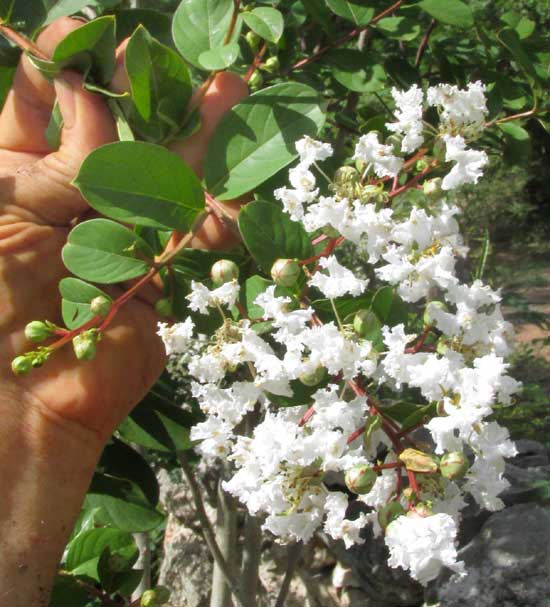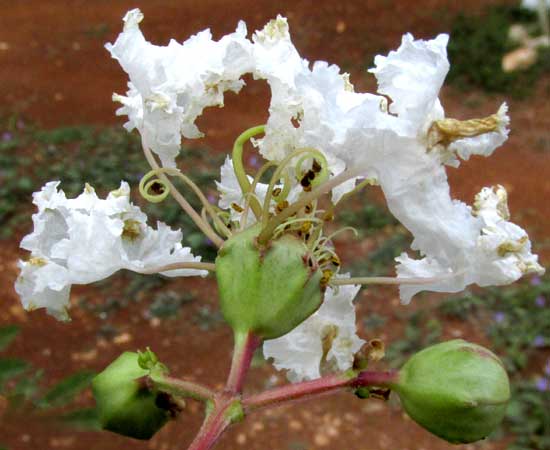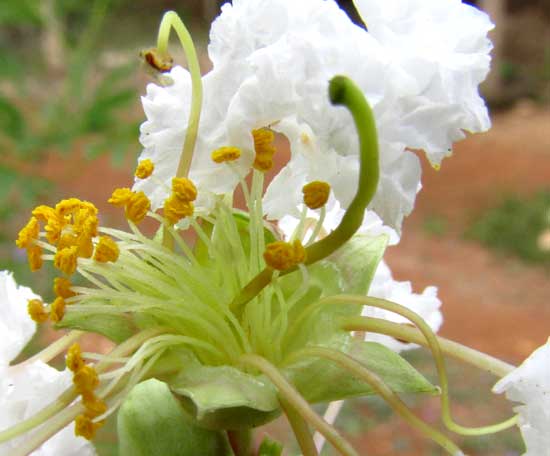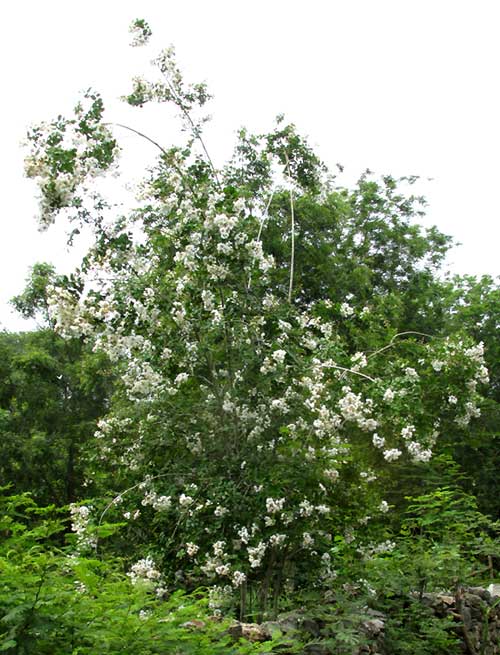Excerpts from Jim Conrad's
Naturalist Newsletter
from the June 11, 2017 Newsletter issued from Rancho Regenesis in the woods ±4kms west of Ek Balam Ruins; elevation ~40m (~130 ft), N20.876°, W88.170°; north-central Yucatán, MÉXICO
CRAPE-MYRTLES FLOWERING
Next to the garden, during the dry season from about February to the end of May, a 15-ft-tall bush stood leafless and scraggly looking. With the advent of the rainy season, the bush leafed out quickly, panicles of pea-sized, spherical flower buds formed, and now the plant is in full flower. The flowers surprised me because one of the Maya guys had told me the leafless tree was a Pomegranate, and also to me its leaves looked like those of a Pomegranate, but the flowers turned out to not even be close close to Pomegranate flowers. You can see them below:

A close-up of a blossom shot from behind, showing crinkled petals' extending from a cup-like calyx on slender "claws," is shown below:

A frontal close-up showing a flower's many stamens clustered around the base of a single slender, curved style -- the style being a "neck" atop the stamen-hidden ovary and tipped with the stigma -- is shown below:

I'd seen this unusual flower structure back in the southern US, where it's seen on one of the most frequently planted ornamental bushes. However, up there I'm used to the petals being pink, and normally the US shrubs grow more compactly than our rangy looking ones. It's the Crape-Myrtle, LAGERSTROEMIA INDICA, originally from Asia and northern Australia but now cultivated and sometimes going wild in the American tropics and the Southern US.
White Crape-Myrtles are commonly seen here in little Maya villages and along the road, but so far I've not seen pink ones like those up North. Up North Crape-Myrtles are regarded as exceptionally handsome plants, and they are, but down here they hardly stand out in a landscape thick with Bougainvilleas, Royal Poincianas and other such majestic presences.
from the June 18, 2017 Newsletter issued from Rancho Regenesis in the woods ±4kms west of Ek Balam Ruins; elevation ~40m (~130 ft), N20.876°, W88.170°; north-central Yucatán, MÉXICO
CREPE-MYRTLES VS POMEGRANATES
This week the rancho's Crepe-Myrtles are even fuller of blossoms than last week, as shown below by a tree next to the garden:

Before the rancho's Crepe-Myrtles issued their flowers, I asked the Maya workers here what tree it was. Granada, I was told: Pomegranate. That sounded OK to me, because the leaves looked like Pomegranate leaves, though the tree seemed larger than Pomegranate trees I'd seen. Our Pomegranate page where you can compare the leaves is at www.backyardnature.net/yucatan/punica.htm
On that page you see that Pomegranate flowers are large, reddish, leathery-looking ones that do not gather in large clusters the way Crepe-Myrtle flowers do.
Despite the big differences between Crepe-Myrtle and Pomegranate flowers, this week I've learned that not only the rancho's Maya workers but everyone in the area calls our white-flowered Crepe-Myrtles Granadas, or Pomegranates. Lee, the rancho's owner, tells me that when she bought our Crepe-Myrtles at a nursery, they were labeled as Granadas.
Issued June 25, 2020 from Tepakán, Yucatán, MÉXICO
PINK FLOWERS
In Tepakán both the white- and pink-flowered forms are planted, though the pink ones are most common. Below you see a typical bush:

A pink flower close up is shown below:
